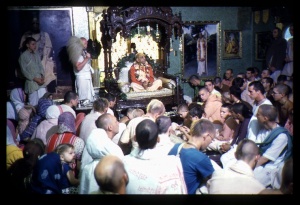SB 4.25.16

A.C. Bhaktivedanta Swami Prabhupada
TEXT 16
- sabhā-catvara-rathyābhir
- ākrīḍāyatanāpaṇaiḥ
- caitya-dhvaja-patākābhir
- yuktāṁ vidruma-vedibhiḥ
SYNONYMS
sabhā — assembly houses; catvara — squares; rathyābhiḥ — by streets; ākrīḍa-āyatana — gambling houses; āpaṇaiḥ — by shops; caitya — resting places; dhvaja-patākābhiḥ — with flags and festoons; yuktām — decorated; vidruma — without trees; vedibhiḥ — with platforms.
TRANSLATION
In that city there were many assembly houses, street crossings, streets, restaurants, gambling houses, markets, resting places, flags, festoons and beautiful parks. All these surrounded the city.
PURPORT
In this way the capital is described. In the capital there are assembly houses and many squares, many street crossings, avenues and streets, many gambling places, markets and places of rest, all decorated with flags and festoons. The squares are surrounded with railings and are devoid of trees. The heart of the body can be compared to the assembly house, for the living entity is within the heart along with the Paramātmā, as stated in Bhagavad-gītā (BG 15.15): sarvasya cāhaṁ hṛdi sanniviṣṭo mattaḥ smṛtir jñānam apohanaṁ ca. The heart is the center of all remembrance, forgetfulness and deliberation. In the body the eyes, ears and nose are different places of attraction for sense enjoyment, and the streets for going hither and thither may be compared to different types of air blowing within the body. The yogic process for controlling the air within the body and the different nerves is called suṣumnā, the path of liberation. The body is also a resting place because when the living entity becomes fatigued he takes rest within the body. The palms and the soles of the feet are compared to flags and festoons.